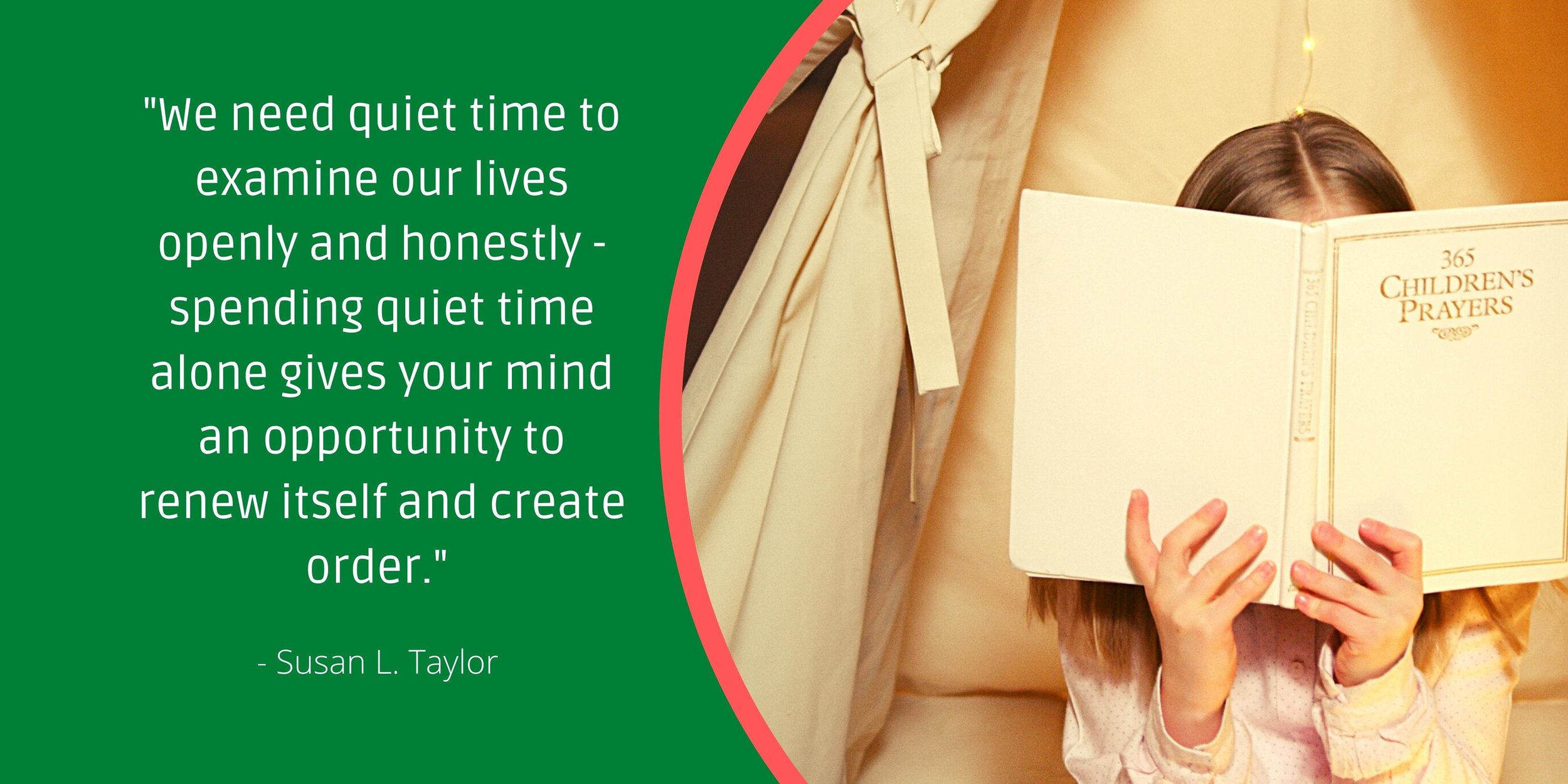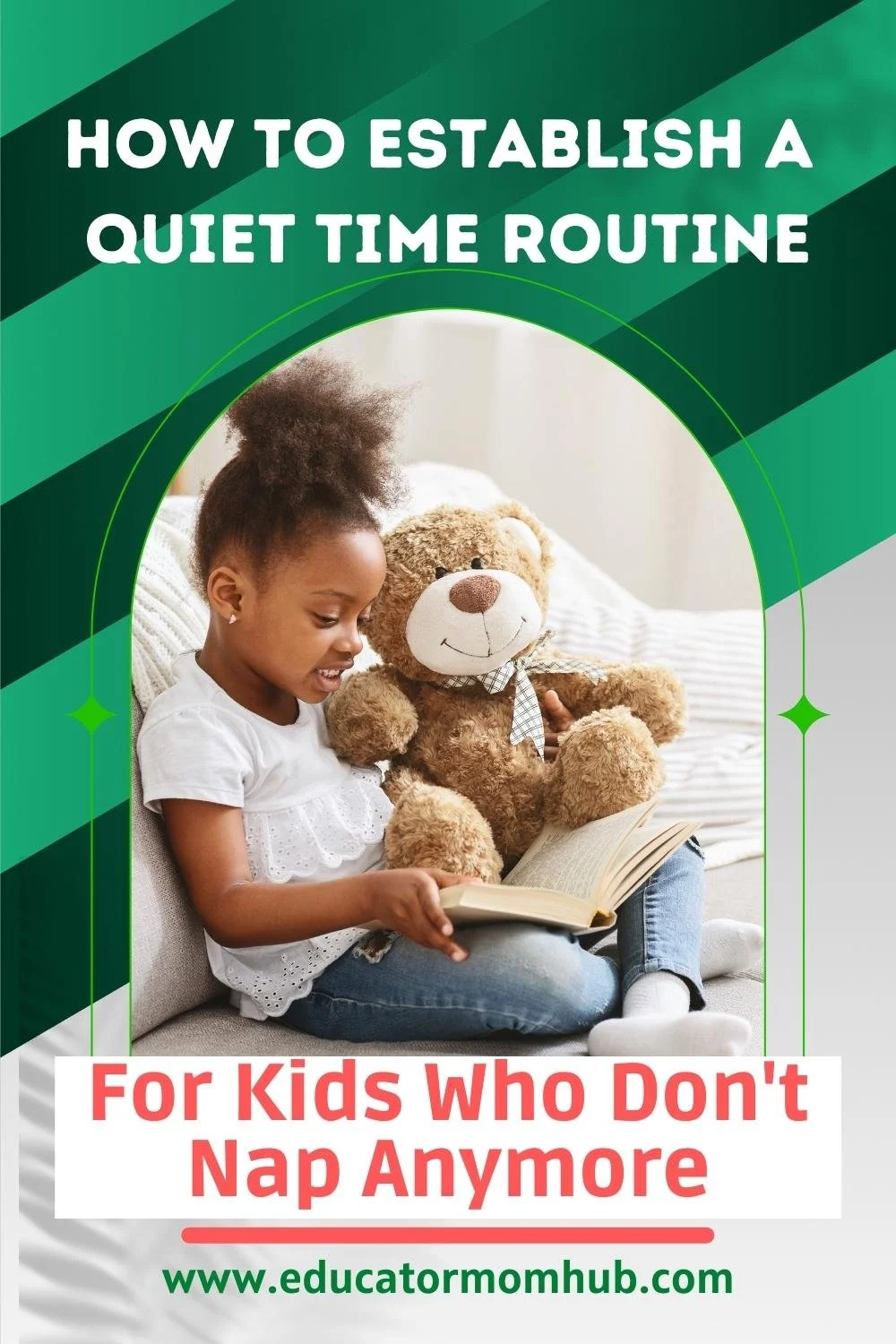How to Transition Kids from Nap Time to Quiet Time- For Kids Who Don't Nap Anymore
Moms of kids who don't nap during the day often feel at a loss about what to do with them.
It can be tough to transition them from a time when they were napping all the time to suddenly not napping at all.
But introducing quiet time can be a great way to help them relax and recharge without driving you crazy in the process.
This can be a time when they read, play quietly, or just relax without any screen time.
Kids need to have this time to themselves so they can decompress and rejuvenate.
The Benefits of Quiet Time for Kids
It's important to introduce quiet time for kids who don't nap in the daytime anymore for a few reasons.
Quiet time gives kids a chance to wind down after a busy morning of learning and playing. It's important for them to have some time to relax and recharge before the afternoon activities begin.
Quiet time gives kids an opportunity to practice independent play. They can choose quiet activities like reading time, listening to music, or just playing quietly. This unstructured play is a valuable practice for when they're older and won't have someone telling them what to do every minute of the day.
Quiet time is a great opportunity for parents to get some much-needed break as well. They can use this time to put their feet up and enjoy a cup of coffee or tea while the kids are occupied.
In short, quiet time is beneficial for both kids and parents alike. So if your child no longer naps during the day, be sure to introduce quiet time into their daily routine.
Here is a helpful article: Should Pre-Schoolers Nap at Daytime?-The Benefits, When to Stop, Alternatives to Nap
How to Establish a Quiet Time Routine
Now that we know why quiet time is important, let's talk about how to establish a routine.
The first step is to decide what time of day quiet time will happen. It's usually best to do it in the afternoon after lunch and before the start of afternoon activities.
The second step is to choose a duration for quiet time. This can be anywhere from 30 minutes to an hour.
The third step is to establish some quiet time rules. For example, you might tell your kids that during quiet time they need to stay in their room, play independently, and not disturb others.
The fourth step is to provide some activities for your kids to do during quiet time. This can be anything from reading books to quietly playing with toys to listening to music.
The fifth and final step is to stick to the routine. It's important to be consistent with quiet time so that it becomes a habit for both kids and parents.
If you follow these steps, you'll be well on your way to establishing a successful quiet time routine for your kids.
Tips for Making Quiet Time Successful
There are a few things you can do to make sure quiet time is successful.
1. Make Sure that the Environment is Relaxing.
This means making sure the room is quiet and free of distractions.
You can close the door, turn off the television, and put away any toys that might make noise. You can also dim the lights to create a more calming atmosphere.
Provide some comfortable pillows and blankets for your kids to use during quiet time. This will help them get cosy and feel relaxed.
2. Give Them a Warning
Before quiet time begins, give your kids a 5-minute warning so they can start wrapping up whatever activity they're doing.
3. Let Kids Know What to Expect
Be sure to explain to your kids what they should expect during quiet time.
This will help them understand the purpose of quiet time and be more cooperative.
4. Use a Positive Tone
When introducing the concept of quiet time to your kids, be sure to use a positive tone.
This will help them see that quiet time can be a fun and relaxing experience.
5. Offer Some Encouragement
Offer some words of encouragement to your child before they start their quiet time.
This will help them feel more positive about the experience.
For example, you can say, "I know you're going to do a great job at relaxing during quiet time."
6. Be Flexible
If your child is having a hard time settling down, be a little flexible with the rules.
Maybe let them listen to calm music or have a favourite stuffed animal with them during quiet time.
The important thing is that they're taking some time to relax and unwind.
7. Set a timer
Let your child know when the quiet time will be over by setting a timer or an alarm clock.
This will help them better manage their time and not get too antsy.
8. Don't Make it a Punishment
Quiet time should be a peaceful and calming experience.
It shouldn't be used as a punishment for bad behaviour.
If your child is having a hard time following the rules, try gently reminding them of the expectations.
9. Give Them a Hug
End quiet time with a hug and some words of praise.
This will help your child feel loved and appreciated, and it will reinforce the positive experience of quiet time.
10.Don't Feel Guilty
Many children stop napping by the time they reach preschool age.
For parents of these toddlers and pre-schoolers, daily quiet time can be a way to ensure that their child gets the rest they need.
When kids rest, parents can sneak in a couple of uninterrupted hours to relax, and recharge themselves.
This will help you be a better parent (mom), and there's no need to feel guilty about it.
So go ahead and give daily quiet time a try - your child (and you) will be glad you did.
Here is an article: How to Overcome Mom Guilt for Needing a Break
What Is a Quiet Time Box?
A "quiet time box" can be a great way to help toddlers transition from nap time to quiet time.
It can be a special box or container where your toddler puts all of their favorite quiet-time activities.
This could include books, puzzles, colouring books, play dough, and any other activities that help your child play quietly.
During daily quiet time, your child can choose any activity from their quiet time box to keep them occupied.
Quiet Time Activities
1. Reading Books
Encourage your child to read during quiet time.
This is a great way for them to unwind and chill.
Choose books that are calm and soothing, such as bedtime stories or picture books.
Make sure to have a variety of books available in your child's room or in the quiet time box so they can find something that interests them.
2. Playing with Toys
If your child enjoys playing with toys, make sure to have a few quiet options available.
This could be anything from dolls, animals, cars, or little figurines.
This sea animal set comes with a ocean mat that can engage kids into hours of quiet imaginative play.
3. Drawing or Colouring
Arts and crafts can be a great way for kids to express themselves and de-stress during quiet time.
Add crayons, markers, colouring books, and other supplies available in your child's room so they can engage in this experience in the room quietly.
These coloring books come in a pack of 15 books with a variety of themes.
4. Doing Puzzles
Puzzles are another great quiet time activity for children.
They help with problem-solving skills and can be very calming.
Start with simple puzzles and then move on to more difficult ones as your child gets older.
5. Listening to Calm Music
If your child enjoys listening to music, make sure to have some calming tunes available for them.
This could be classical music, nature sounds, or even white noise. Choose something that will help your child rest and focus.
This white noise machine is equipped with 42 soothing sounds including 15 lullabies and 15 natural sounds to promote a relaxing environment and longer sleeps.
6.Play Dough
Play dough is a great way for kids to use their imaginations and be creative. It can also be very calming and soothing.
7. Stuffed Animals
Stuffed animals can be a great source of comfort for kids during quiet time.
They can help your child feel safe and loved.
Make sure to have a few of your child's favorite stuffed animals available in their resting space.
8. Books on Tape
If your child enjoys listening to stories, books on tape are a great option for rest time.
This way, your child can listen to the story without having to read it. Have a few different options available so your child can choose what they would like to listen to.
Keep in mind that you don't have to provide everything from the above suggestions at the same time. This would overwhelm the child and defeat the purpose of quiet times. Let your child choose only one or two activities per day.
How to Keep Quiet Time Activities Interesting and Engaging
1. Rotate Toys
It's important to keep the quiet time play engaging and fresh for children. This means rotating the activities every so often. This will keep them interested and avoid boredom.
2. Let Them Choose Their Own Activity
Another way to keep the rest times interesting is to let your child choose their activity. This will help them feel empowered and in control of their experience.
3. Add New Activities
Every so often, add new quiet play resources to keep things fresh. This could be anything from a new book to a new puzzle or coloring book.
4. Set Up a Quiet Time-Space
If you have the space, set up a special quiet time area in your child's room.
This could be a corner with a cosy blanket and some pillows. This will help create a calm and relaxing environment for your child to enjoy their activities.
Here is an article: 7 Reasons Why All Kids Need A Calming Corner And How To Create One
5. Make it Fun!
Remember that quiet time should be a fun and positive experience for your child.
Make sure to praise them and show them how proud you are of their efforts. This will help reinforce the positive experience of quiet time.
What Not to Add to Quiet Time Play
Some activities should be avoided during quiet time. These include anything too stimulating or noisy.
1. Avoid screen time
This includes television, computers, tablets, and phones.
These devices are too stimulating and can be a major distraction during quiet time.
2. Avoid Loud Toys
Toys that make a lot of noise or are otherwise too stimulating should be avoided during rest time.
This includes anything with music or lights.
Choose calm and quiet toys instead.
Avoid adding too many toys to the space so it doesn't feel overwhelming.
3. Avoid Physical Activity
Physical activity is not conducive to relaxation and should be avoided during quiet time.
This includes anything that requires movement, such as running, jumping, or playing with balls.
4. Avoid Sugary Snacks and Drinks
Sugar can cause a quick burst of energy followed by an inevitable crash.
This is not ideal during rest time when the goal is to relax and rejuvenate.
Avoid sugary snacks and drinks during this time.
What If My Child Falls Asleep During Quiet Time?
It's perfectly normal for kids to fall asleep during quiet time, especially if they have had a busy morning or if they are not feeling well.
If this happens, it's no big deal. Just let them sleep and wake them up when quiet time is over.
If you are worried that this unexpected afternoon nap would affect your child's bedtime then having a consistent bedtime routine can be helpful.
Here are two helpful articles that have information on how to establish a bedtime routine for children and some sleep tips and tricks to help them sleep better :
11 Guaranteed Benefits of Having a Bedtime Routine for Kids
7 Reasons Why Kids Sleep Routine Is Crucial For Better Mom Health
Conclusion
Transitioning from nap time to quiet time can be a challenge for kids.
But with a little bit of planning and effort, it can be a positive and enjoyable experience for both you and your child.
By providing them with a space to relax and unwind, you're giving them the opportunity to recharge and be their best selves.
What are your tips for transitioning kids from nap time to quiet time? Let us know in the comments below!
FAQ
1. What is the difference between nap time and quiet time?
Nap time is a period of rest during the day when children can take a nap. Quiet time is a period of rest during the day when children can do calm and quiet activities, such as reading or playing with toys.
2. Why is it important for kids to have quiet time?
Quiet time is important for kids because it gives them the opportunity to relax and rejuvenate. It's also a chance for them to practice self-regulation and focus.
3. What are some good activities for quiet time?
Some good activities for quiet time include reading, puzzles, coloring, and doll play.
4. What should be avoided during quiet time?
Activities that should be avoided during quiet time include anything too stimulating or noisy, such as television, computers, tablets, and phones. Also, avoid sugary snacks and drinks during this time.
5. What if my child falls asleep during quiet time?
If your child falls asleep during quiet time, it's no big deal. Just let them sleep and wake them up when quiet time is over. If you are worried that this unexpected afternoon nap would affect your child's bedtime then having a consistent bedtime routine can be helpful.














